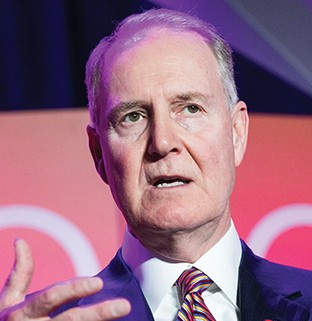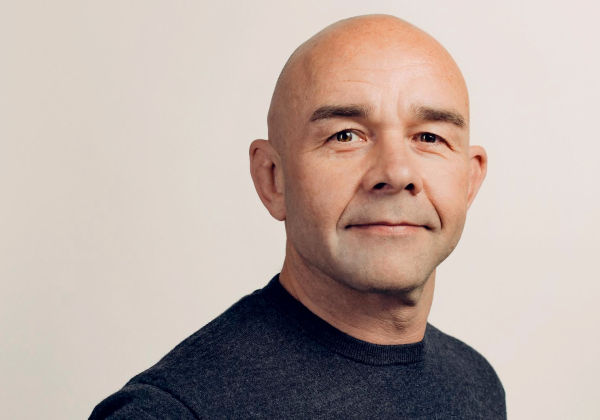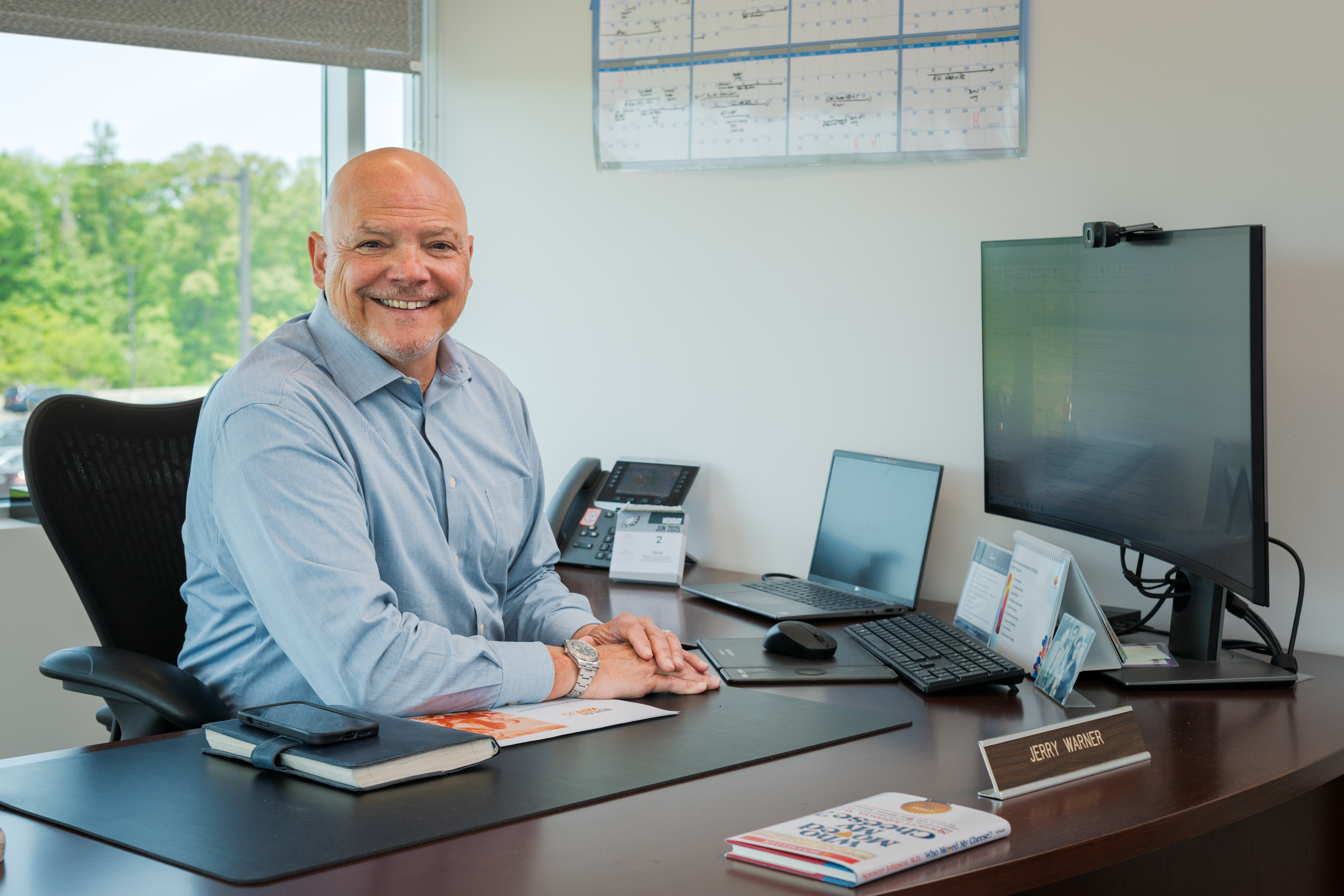Southwest Takes Off Again
Few industries have been more devastated by the COVID-19 pandemic than commercial aviation. So why does Gary Kelly seem so upbeat?
As this issue of Insigniam Quarterly magazine was in the final stages of production in mid-June, Southwest Airlines announced that CEO Gary Kelly will be stepping down in 2022 and will be replaced February 1, 2022, by company veteran Robert Jordan, currently vice president, corporate services. Mr. Kelly will hold the role of executive chairman until at least 2026, according to the June 23, 2021, press release. Mr. Kelly has served as CEO since 2004.
As the chairman and CEO of Southwest Airlines, Mr. Kelly is responsible for flying more passengers annually than any other U.S. carrier. Yet he is flying a lot fewer these days. Southwest saw its operations halved by the pandemic; 4,000 daily flights fell to 2,000 by September. It reported a $3.1 billion loss for the year—its first annual deficit since 1972—and by year’s end, it had filed a WARN notice preparing for its first-ever layoffs. But by this spring, the airline had eked out a first-quarter profit, added destinations at a record clip, rebuilt its daily operations—as of May, it was back to 3,000 flights a day—and positioned itself to dominate post-pandemic air travel.
“Our business model has withstood the test of time, and it’s just been tested again,” Mr. Kelly says. “This was probably the ultimate test. A year ago [in April 2020], our business was almost zero.”
This June, Southwest marks 50 years of operations. What should have been a year of celebration has become one of recovery from some of the biggest challenges in its history. Yet as it has done so many times before, Southwest is turning the crisis to its advantage.
The pandemic, of course, presented Mr. Kelly with challenges familiar to many CEOs, such as stemming precipitous revenue declines and shifting to a remote workforce. But Southwest, which prides itself on its employee-centric culture, struggled with the lack of contact as 15% of its 58,000 employees switched to remote work. While that percentage was smaller than at other companies, that did not make it easier. With so many workers still on the front lines, Southwest needed new lines of communication among work groups.
“We are an in-person company, and trying to strike that balance properly and still manage through the pandemic was messy,” Mr. Kelly says. “Technology has enabled collaboration beyond what I would have ever imagined, although it doesn’t take the place of being in person.”
Mr. Kelly has long believed that strong leadership is built on strong communication and transparency. If you ask employees what they appreciate about him, most will tell you that he spends a lot of time explaining the business to them. Southwest may cultivate a party-in-the-sky image with passengers, but internally, Mr. Kelly does not sugarcoat things.
“The pandemic has devastated travel and tourism,” he told employees in September. “Domestic air travel is at 1970s levels, down 70% from a year ago. Cost and spending have been cut dramatically at Southwest, but not nearly enough to offset a 70% revenue loss.”
“Our business model has withstood the test of time, and it’s just been tested again. This was probably the ultimate test.” —Gary Kelly, chairman and CEO of Southwest Airlines
Mr. Kelly believes that only by getting all employees to understand a problem can they help the company develop solutions—and support those solutions once they are implemented. He does not just say what needs to be done; he explains why it needs to be done.
Southwest’s culture revolves around collaboration, and “collaboration is fundamentally about communication,” Mr. Kelly says. At the pandemic’s onset, he began recording twice-weekly video reports, called “Ask Gary,” in which he was both candid about the crisis and reassuring that Southwest would emerge stronger. Mr. Kelly recorded 72 videos in the first year of the pandemic. (Today he records them monthly.) The tone he strikes is sincere, but encouraging, and employees have responded. Thousands pitched in, taking on extra duties to get the company through the crisis. Those who were initially worried for their safety came to realize that he was looking out for them.
“Our instinct was to get out there and just give people the facts and tell the truth,” Mr. Kelly says. “There’s a lot less anxiety today than there was six or 12 months ago.”
Breaking News
This wasn’t how Mr. Kelly expected things would go during his second decade leading Southwest. Before March 2019, the airline industry had enjoyed several record years. Average operating margins, which dipped below 4% in 2011, rose to between 8% and 15%. Average fuel prices fell to as low as $35 a barrel from more than $110. Southwest entered the pandemic with the strongest balance sheet in its history. It had completed its acquisition of AirTran Airways in 2017 and expanded into Caribbean and Latin American markets in 2014, and Hawaii in 2019.
Then, Mr. Kelly got disturbing news. A 737 Max jetliner had crashed minutes after leaving the airport in Addis Ababa, Ethiopia, killing all 157 people aboard. Less than five months earlier, a Lion Air 737 Max crashed in Indonesia minutes after takeoff, killing 189.
No airline in the world flies more 737s than Southwest—the only aircraft it has ever used—and no one had more Max aircraft than the 34 Southwest already had in service. The carrier’s growth plans hinged on the new plane, which entered service in 2017. Southwest had not had any issues with it, but less than three days after the crash in Ethiopia, the Federal Aviation Administration (FAA) grounded them all. Southwest had to dump its flight schedule, which was so complex it could not make all the changes at once. It had to gradually integrate them in phases across its system. It canceled flights and rebooked passengers, adjusted aircraft scheduling to accommodate the missing planes, and fought to keep service to Hawaii, for which the Max had been slated as the workhorse.
But it also had to be careful. The airline business is brutally competitive, and rivals— many of whom had fewer Max planes and were less affected by the grounding—were eying any opportunities to add flights and steal market share at locations where Southwest had pulled back. So it rotated flight frequencies at various destinations to keep its competitors off guard.
“Our competitors couldn’t make any long-term determination what our plans were,” Mr. Kelly says. “We didn’t want them to think that we were pulling down service in a city and give them an opportunity to rush in a lot of capacity that would sort of preempt us from returning.”
Mr. Kelly knows market dominance in the airline business can be fleeting. You cannot allow your competitors a foothold, no matter how strong your position. The adjustments had to keep its rivals guessing while awaiting the Max’s return (which kept getting delayed), which meant Southwest’s network planning team had to adjust schedules constantly, faster and on a larger scale than ever.
Despite the disruptions, Southwest still managed to report near-record profits, but losing the Max cost hundreds of millions of dollars in revenue and forced the company to suspend its growth plans. By the time the FAA cleared the plane to return to service, in November 2020, the industry was embroiled in the pandemic.
“In March and April [2020], we had dozens of flights that were flying around with not one paying passenger on them.” —Gary Kelly
“One benefit of working through the Max challenge was [when the pandemic hit] we knew how to make rapid and frequent adjustments to our flight schedules and align our seats to radically changed demand,” Mr. Kelly said. “In March and April [2020], we had dozens of flights that were flying around with not one paying passenger on them.”
Thirty-five years at Southwest has taught Mr. Kelly that every crisis breeds innovation. Workers can figure out what to do if you give them the freedom and encouragement to succeed.
Big Shoes To Fill
Mr. Kelly, 66, who has an accounting degree from the University of Texas at Austin, joined Southwest in 1986 as controller. He quickly distinguished himself by creating, in just three months, the company’s first frequent flyer program.
Four years later, he developed a system for hedging fuel costs as oil prices spiked after Iraq invaded Kuwait. Hedging became a competitive weapon for Southwest—fuel is an airline’s biggest expense after payroll—and almost every other airline has since copied the tactic.
In 2003, Mr. Kelly, who by then was CFO, found himself stepping into some of the biggest shoes in commercial aviation. Southwest’s legendary founder, Herb Kelleher, stepped down as CEO in 2001, and, after a couple of years under the airline’s former general counsel, Jim Parker, Mr. Kelly ascended to the job. Mr. Kelleher, who died in 2019, remained chairman until 2008; he was always willing to offer advice, but he made it clear that Mr. Kelly was calling the shots. His office is still lined with pictures of him and “Herb.”
Mr. Kelleher was known for his audacity; Mr. Kelly is more reserved. While Mr. Kelleher had a larger-than-life persona, talking to Mr. Kelly is more like chatting with your best friend’s dad. He is calm and measured, yet personable, which resonates with employees.
Fun and Fiscal Discipline
Southwest is known for its “fun” image—singing flight attendants, gates decorated for Halloween, and a founder who was not above donning an Elvis jumpsuit or arm-wrestling a competitor for the rights to a marketing slogan. But the chain-smoking Mr. Kelleher also infused the company’s culture with an important principle: “We figure there’s going to be at least two crises in every decade, and we’d better be ready for them,” he said. “My slogan has always been, ‘We manage in good times so that we’ll do well in bad times.’”
Southwest may look irreverent on the outside, but inside, it is guided by strict financial discipline that embodies Mr. Kelleher’s slogan. “We want to be aggressive; we want to be bold, we want to be audacious,” Mr. Kelly says. “And at the same time, we want to be conservative. So it’s a real juxtaposition of things to manage.”
“If we can add a flight and at least cover our operating costs, then we will add it, and that will help shrink our losses.” —Gary Kelly
Mr. Kelleher’s insistence on financial discipline has served Southwest well. It is the only major U.S. airline that has never gone bankrupt or laid off employees, who are some of the highest-compensated in the industry; its executive salaries are among the lowest.
Southwest recovered more quickly than other carriers after 9/11 in part because it had one of the strongest financial positions in the industry. With the pandemic, it was much the same. It entered the pandemic with $4 billion in cash and raised almost $19 billion more during the next year, boosting liquidity and preserving its investment-grade bond ratings. It started the crisis with a 24% leverage ratio, which rose to 56%, but having a strong balance sheet at the outset gave it the flexibility to tap debt markets to get through the crisis.
But it still was not enough. Canceling flights saves some operational expenses, but many costs, such as payroll, remain. “The pandemic proved that you can lose all your revenue, but you don’t lose all your costs,” Mr. Kelly says. Southwest’s top executives took a 20% pay cut, and Mr. Kelly agreed to take his base salary to $0. Nonunion employees were also asked to take a 10% cut. Some union workers bristled, and Mr. Kelly warned layoffs might be the only option, but Congress extended payroll protections into the spring, and Southwest averted furloughs and pay cuts for all employees. To survive the pandemic, though, it was going to need something else: revenue.
Mr. Kelly can seem subdued in conversations, but he learned the business from one of the industry’s fiercest competitors—Mr. Kelleher—who often invoked military terminology in discussing strategy or fending off rival airlines. Southwest, after all, started with just three airplanes and spent years battling other carriers in court just for the chance to fly.
Late last year, Mr. Kelly decided to launch an offensive. Since November 2020, Southwest has added 17 destinations, many of them smaller cities such as Bozeman, Montana, and Myrtle Beach, South Carolina.
“That’s just taking a page out of Herb’s book,” Mr. Kelly says. “We have to have sufficient numbers of customers to break even, and to generate those customers we have to provide a sufficient number of seats.”
The trick, especially when few people are flying, is to find the balance. Fly too many empty seats and sacrifice profit; fly too few flights and sacrifice desperately needed revenue. Mr. Kelly and his leadership team quickly concluded that the airline could not make money operating 2,000 flights a day.
Finding Revenue
Needing revenue, they resorted to a tactic that has always worked for Southwest: adding destinations. As far back as 1993, the U.S. Department of Transportation documented that when Southwest enters a market, more people start flying. In other words, Southwest does not take passengers away from rivals as much as it expands the market.
Could this “Southwest Effect” help pull the company out of the pandemic’s malaise? Its flight schedules are defined by density, and much of the company’s growth comes from targeting larger cities. But this time, Mr. Kelly believed plugging smaller cities into the network might generate revenue.
Some of the new cities will support only a few daily departures. Others may be able to handle as many as 10. That is a far cry from the more than 220 at Chicago Midway or even the 150 at its home base at Dallas Love Field, but it is still enough to make money.
“If we can add a flight and at least cover our operating costs, then we will add it, and that will help shrink our losses,” Mr. Kelly says. “We’re already paying for the airplanes. We already have excess staffing.”
Combined, the 17 new cities will put as many as 40 planes back to work. Mr. Kelly said the strategy is paying off, and he does not see it as just a short-term fix. The air travel recovery is being driven by leisure customers. Business travel—the mainstay of most airlines’ pre-pandemic profits—was still down 85% in the first quarter compared to a year earlier.
“A lot of the destinations we’re adding are more leisure oriented,” Mr. Kelly says. “We have a very strong belief that air travel will be dominated by leisure travel. And these are permanent additions to our route map.” In other words, Southwest is making moves to profit from what many analysts believe will be a long-term shift in the travel market. With the 737 Max back in service and hundreds of millions of vaccinated Americans ready to catch up on lost vacations and family visits, Southwest is poised once again to lead the industry out of some of its darkest days. Daily flights now number more than 3,000, still well below pre-pandemic levels but well above 2020’s nadir.
“We are in a much better place,” Mr. Kelly said. “We have so much to look forward to.”
This article appeared in the Summer 2021 issue of Insigniam Quarterly. To begin receiving IQ, go here.




